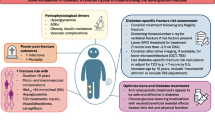Abstract
Discordance has been proposed as a new predictor of fracture risk that may affect fracture risk via bone mineral density (BMD). With an emphasis on better understanding the relationship between discordance and BMD, the aim of this study was to determine the effect of the number of osteoporotic sites, as an indicator of discordance, on BMD and to explore the clinical significance of BMD modification by this factor. This study was based on data obtained from the Korea National Health and Nutrition Examination Survey 2008–2011, which is a nationwide cross-sectional study. Among postmenopausal women aged 50 years or older, 3,849 women whose BMD was measured at three sites (lumbar spine, femoral neck, and total hip) were included in the study. The diagnosis was consistent across sites in only 39.2–59.0 % of cases. Lumbar spine T-score was reduced by 0.163 for two osteoporotic sites and by 0.462 for three osteoporotic sites, compared with having one osteoporotic site at the lumbar spine only. Femoral neck T-score was reduced by 0.609 for three osteoporotic sites compared with one or two osteoporotic sites. Using BMD adjusted for discordance, we found fracture risk probability changed significantly. Our results confirmed that BMD discordance was considerably high among Korean women in their 50s and older owing to site-dependent differences in the pattern of BMD reduction with age. Mean BMD decreased with increasing number of osteoporotic sites. Using a modified BMD adjusted for the number of osteoporotic sites may offer more accurate fracture risk assessment.


Similar content being viewed by others
References
Larcos G (1998) Predicting clinical discordance of bone mineral density. Mayo Clin Proc 73:824–828
Abrahamsen B, Hansen TB, Jensen LB, Hermann AP, Eiken P (1997) Site of osteodensitometry in perimenopausal women: correlation and limits of agreement between anatomic regions. J Bone Miner Res 12:1471–1479
O’Gradaigh D, Debiram I, Love S, Richards HK, Compston JE (2003) A prospective study of discordance in diagnosis of osteoporosis using spine and proximal femur bone densitometry. Osteoporos Int 14:13–18
Woodson G (2000) Dual X-ray absorptiometry T-score concordance and discordance between the hip and spine measurement sites. J Clin Densitom 3:319–324
National Osteoporosis Guideline Group (2013) Clinician’s guide to prevention and treatment of osteoporosis. National Osteoporosis Foundation, Washington
Lewiecki EM, Gordon CM, Baim S, Leonard MB, Bishop NJ, Bianchi ML, Kalkwarf HJ, Langman CB, Plotkin H, Rauch F, Zemel BS, Binkley N, Bilezikian JP, Kendler DL, Hans DB, Silverman S (2008) International Society for Clinical Densitometry 2007 adult and pediatric official positions. Bone 43:1115–1121
Kanis JA, McCloskey EV, Johansson H, Cooper C, Rizzoli R, Reginster JY (2013) European guidance for the diagnosis and management of osteoporosis in postmenopausal women. Osteoporos Int 24:23–57
Kanis JA on behalf of the WHO Scientific Group (2007) Assessment of osteoporosis at the primary health care level. World Health Organization Collaborating Centre for Metabolic Bone Diseases, University of Sheffield, Sheffield, pp 13–44
Marshall D, Johnell O, Wedel H (1996) Meta-analysis of how well measures of bone mineral density predict occurrence of osteoporotic fractures. BMJ 312:1254–1259
Kanis JA, Johnell O, Oden A, Johansson H, Hisman JA, Fujiwara S, Kroger H, Honkanen R, Melton LJ 3rd, O’Nell T, Reeve J, Silman A, Tenenhouse A (2006) The use of multiple sites for the diagnosis of osteoporosis. Osteoporos Int 17:527–534
Stone KL, Seeley DG, Lui LY, Cauley JA, Ensrud K, Browner WS, Nevitt MC, Cumming SR (2003) BMD at multiple sites and risk of fracture of multiple types: long-term results from the study of osteoporotic fractures. J Bone Miner Res 18:1947–1954
Leslie WD, Lix LM, Johansson H, Oden A, McCloskey E, Kanis JA (2011) Spine-hip discordance and fracture risk assessment: a physician-friendly FRAX enhancement. Osteoporos Int 22:839–847
Leslie WD, Kovacs CS, Olszynski WP, Towheed T, Kaiser SM, Prior JC, Josse RG, Jamal SA, Kreiger N, Goltzman D (2011) Spine-hip T-score difference predicts major osteoporotic fracture risk independent of FRAX: a population-based report from CAMOS. J Clin Densitom 14:286–293
Leslie WD, Tsang JF, Caetano PA, Lix LM (2007) Number of osteoporotic sites and fracture risk assessment: a cohort study from the Manitoba bone density program. J Bone Miner Res 22:476–483
Korea Centers for Disease Control and Prevention (2008–2009) The fourth Korea National Health and Nutrition Survey (KNHANES IV). http://knhanes.cdc.go.kr/knhanes/. Accessed 26 May 2014
Korea Centers for Disease Control and Prevention (2010–2011) The fifth Korea National Health and Nutrition Survey (KNHANES V). http://knhanes.cdc.go.kr/knhanes/. Accessed 26 May 2014
World Health Organization Oollaborating Centre for Metabolic Bone Diseases FRAX® WHO fracture risk assessment tool. http://www.shef.ac.uk/FRAX/tool.aspx?country=25. Accessed 4 Aug 2014
Yoshimura N, Kinoshita H, Danjoh S, Takijiri T, Morioka S, Kasamatsu T, Sakata K, Hashimoto T (2002) Bone loss at the lumbar spine and the proximal femur in a rural Japanese community, 1990–2000: the Miyama study. Osteoporos Int 13:803–808
Leslie WD, Lix LM, Johansson H, Oden A, McCloskey E, Kanis JA (2012) A comparative study of using non-hip bone density inputs with FRAX®. Osteoporos Int 23:853–860
Soen S, Fukunaga M, Sugimoto T, Sone T, Fujiwara S, Endo N, Gorai I, Shiraki M, Hagino H, Hosoi T, Ohta H, Yoneda T, Tomomitsu T (2013) Diagnostic criteria for primary osteoporosis: year 2012 revision. J Bone Miner Metab 31:247–257
Conflict of interest
The authors declare that they have no conflict of interest.
Author information
Authors and Affiliations
Corresponding author
About this article
Cite this article
Lee, J.S., Lee, S., Ryu, OH. et al. Number of osteoporotic sites as a modifying factor for bone mineral density. J Bone Miner Metab 33, 684–693 (2015). https://doi.org/10.1007/s00774-014-0635-1
Received:
Accepted:
Published:
Issue Date:
DOI: https://doi.org/10.1007/s00774-014-0635-1




